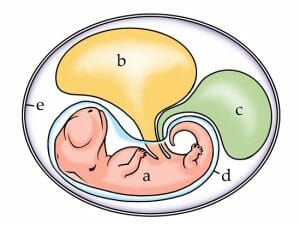Allantois Definition
The allantois is one of the four main membranes that surround an embryo. It is found near the posterior of the embryo, since that’s where its development begins. The allantois is characteristic of reptiles, birds, and mammals, and lies between two other extraembryonic membranes: the amnion, the innermost layer, which covers and protects the embryo; and the chorion, which is the outermost layer, housing the embryo and all the other extraembryonic membranes. The fourth and last structure is the umbilical vesicle, which is also called the yolk sac in birds and reptiles. Together, these four membranes protect the embryo and prevent its drying out. They are also responsible for the control of gas exchange and for providing nutrients for the developing embryo.
The presence of the chorion, allantois, yolk sac, and amnion leads to the identification of an organism as an amniote. Below, the structure marked with the letter ‘a’ is the embryo, while ‘b’ represents the yolk sac, ‘c’ represents the allantois, ‘d’ represents the amnion, and ‘e’, the chorion. As can be seen, the amnion is found very close to the embryo, the chorion surrounds all of the other membranes as well as the embryo, and the yolk sac and allantois form pouches that are connected to the embryo.
The allantois is a very important structure that grows to a large size in non-humans. However, while it is also important in human, it is only a small outgrowth of the developing digestive tract. Of all vertebrates, only fish and amphibians, such as frogs, do not possess an allantois during development.
Function of Allantois
The allantois stores urinary waste, and helps with the exchange of gases in general, which makes it a crucial structure since it delivers oxygen to the embryo. It also has a very important role in egg-laying animals, including all birds, as it serves as the embryo’s respiratory organ together with the chorion.
Somewhere between the fifth and seventh weeks of embryonic development, the allantois becomes a fibrous cord that is referred to as the urachus, the function of which is to drain the fetus’s urinary bladder. The urachus runs through the umbilical cord, which is a connection between the embryo or fetus and the placenta in placental mammals like humans.
Related Biology Terms
- Caul – A portion of a membrane that can be present at birth covering the head of the newborn.
- Placenta – The organ that provides a connection between the embryo and the wall of the uterus.
- Zygote – A eukaryotic cell that results from the fusion of an ovule with a pollen grain or an ovum with a sperm’s nucleus.
Quiz
1. Which of the following is not one of the membranes that are found around an embryo?
A. Yolk sac
B. Amnion
C. Amniote
D. Chorion
2. What does the allantois become in humans after some time?
A. The placenta
B. The urachus
C. The amniote
D. The chorion
3. Which of the following is not true of the allantois?
A. It is the innermost extraembryonic membrane
B. It helps to obtain oxygen for the embryo
C. It stores urinary waste
D. It is one of four extraembryonic membranes

